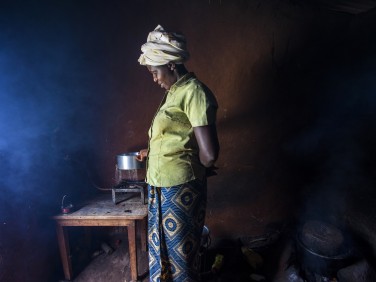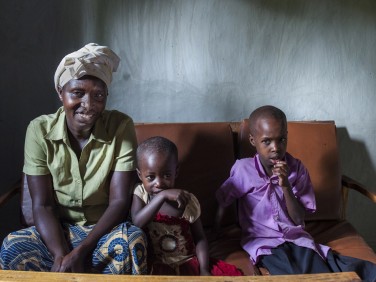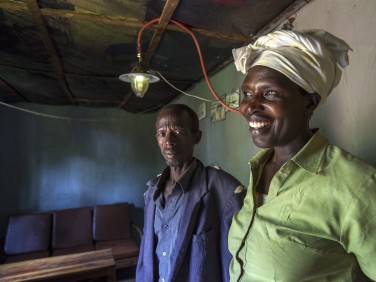
Meet Gloria, the former refugee growing crops – and profits
It took 15 years for Gloria Kabagwira to get back to her native Rwanda. With the right training and access to credit, it only took three more for the 46-year-old to become one of her district’s most successful farmers.
A country of farmers
Rwanda is on the rise. In its efforts to meet the Millennium Development Goals, says the UN, the country was “top-performing”. But despite a sizeable mining sector and ambitious government plans to electrify 70 percent of homes and businesses by 2017, Rwanda’s economy remains overwhelmingly agricultural. Almost 80 percent of the population is engaged in farming, most at the subsistence level.
 Gloria’s village is no exception. Here in Mpanga, some 12 miles from the nearest paved road, homes are made from mud bricks, electricity is non-existent and the nearest water pump is a good half-mile away. “And it’s not good water,” she says.
Gloria’s village is no exception. Here in Mpanga, some 12 miles from the nearest paved road, homes are made from mud bricks, electricity is non-existent and the nearest water pump is a good half-mile away. “And it’s not good water,” she says.
Twenty years ago, the Rwandan genocide claimed an estimated 800,000 lives. Another 800,000 people were displaced. Gloria, who returned from Tanzania in 2009 after the government promised her a free hectare of land, was among them. “When we came back we were poor. The government gave us the land but we did not know how to use it,” she says. “We survived because in this area it is easy to grow bananas and maize. Not much else, though.”
Mpanga region, Rwanda
Life savings
Things began to change in 2011 when Gloria joined a local community savings group, compelled by a mixture of curiosity and desperation. For the first time in her life, the mother of eight had access to skills and business training.
 Crucially, she could also access credit via the group fund. “I contributed 400 Rwandan Francs (US $0.60) a week by working in the fields,” she says. “It wasn’t easy, but it was worth it.” Before long, the 30-strong group was ready to start lending. Gloria, meanwhile, was ready to borrow. “I was growing a few crops to eat but I knew that if I grew tomatoes and cabbages then I would be able to sell them, so I took a loan from the group of 25,000 RWF (US $36) to buy tomato seedlings,” she says. “It was a lot. I was afraid how to pay it back, it was so big.” But pay it back she did. Today, Gloria’s crops bring in some 500,000 RWF (US $720) a season, $250,000 RWF (US $360) in pure profit. And she isn’t stopping there.
Crucially, she could also access credit via the group fund. “I contributed 400 Rwandan Francs (US $0.60) a week by working in the fields,” she says. “It wasn’t easy, but it was worth it.” Before long, the 30-strong group was ready to start lending. Gloria, meanwhile, was ready to borrow. “I was growing a few crops to eat but I knew that if I grew tomatoes and cabbages then I would be able to sell them, so I took a loan from the group of 25,000 RWF (US $36) to buy tomato seedlings,” she says. “It was a lot. I was afraid how to pay it back, it was so big.” But pay it back she did. Today, Gloria’s crops bring in some 500,000 RWF (US $720) a season, $250,000 RWF (US $360) in pure profit. And she isn’t stopping there.
A capital idea
Between her own savings and help from the Rwandan government’s agricultural grants scheme, also facilitated by the group, Gloria has managed to build a water reservoir and instal her own biogas system, erasing the need to forage for fuel. She’s also expanded her acreage to grow passion fruit and papaya.
She credits her new income with much more than an improved quality of life. “In Rwanda, if you are a woman you look to everything from your husband. If you need salt, soap or clothes you must ask. You feel like you don’t have value,” she says. “Today I no longer have to beg from my husband. We share responsibility.”
 For all her success, Gloria has even bigger plans for her children:
For all her success, Gloria has even bigger plans for her children:
“I don’t want them to cultivate vegetables. I want them to get a good education and learn to speak English so that they can get good jobs.”
Gloria’s results
![]()
250,000 RWF (US $360) in pure profit per season
One of her district’s most successful farmers
![]()
Greater financial autonomy within the family
Hand in Hand Eastern Africa and CARE Rwanda are co-operating to empower some 100,000 Rwandans, mostly women, to work their way out of poverty by running their own sustainable businesses. The three-year, US $3.2 million partnership is grounded in our shared belief in the power of entrepreneurship to fight poverty.
Next case study: Business as usual: Clementine’s climb from farmer to leader
